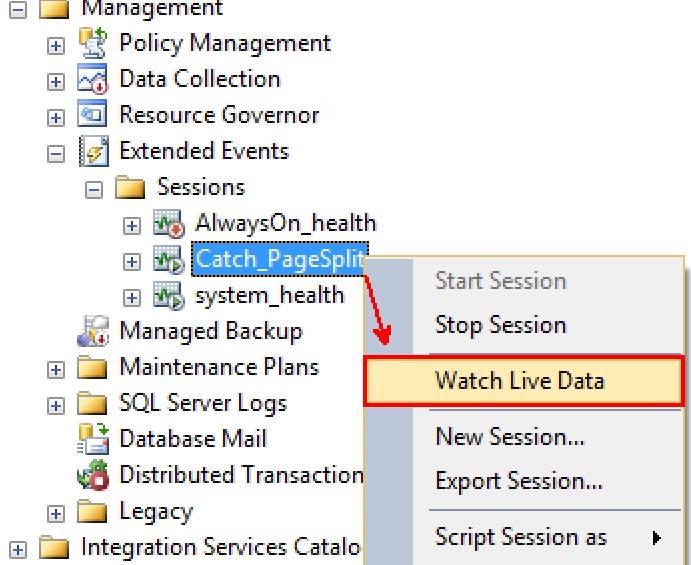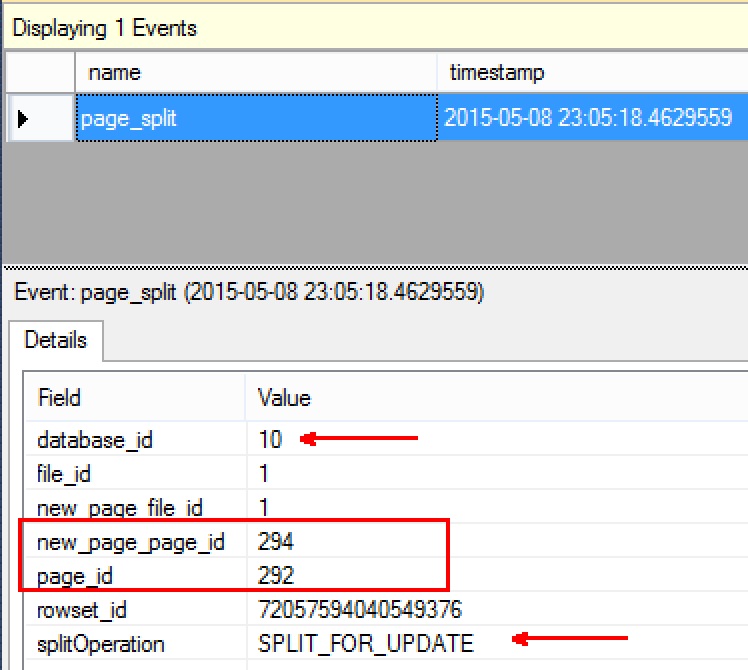In this tutorial, I will show you how to use extended events to identify page splits in SQL Server. The easiest way to track if page splits are happening in SQL Server is to use the PerfMon Counters. For the records you can start from “SQL Server: Access Methods -> Page Splits/sec”. This counter is quite handy to understand if this behavior happens in our SQL Server instance.

Step 1
Let us first create a database for our experiment. We will also create our Extended Event to track the PageSplits.
-- Create a dummy database
CREATE DATABASE PageSplits
GO
-- Get the DB ID, we will use it in next step
SELECT DB_ID('PageSplits')
GO
-- Create Session
CREATE EVENT SESSION [Catch_PageSplit] ON SERVER
ADD EVENT sqlserver.page_split(
WHERE ([package0].[equal_uint64]([database_id],(10)))) -- NOTE: Please make sure you change the DATABASE_ID
ADD TARGET package0.ring_buffer
WITH (MAX_MEMORY=4096 KB,EVENT_RETENTION_MODE=ALLOW_SINGLE_EVENT_LOSS,
MAX_DISPATCH_LATENCY=30 SECONDS,MAX_EVENT_SIZE=0 KB,
MEMORY_PARTITION_MODE=NONE,TRACK_CAUSALITY=OFF)
GO
-- Start the event session
ALTER EVENT SESSION [Catch_PageSplit] ON SERVER
STATE = start;
GO
Step 2
Before we get to the next step, let us start monitoring our Extended Events for any possible page splits.
USE PageSplits
GO
CREATE TABLE mytest (
myCompany CHAR(5) NOT NULL CONSTRAINT pk_mytest PRIMARY KEY CLUSTERED,
FillData VARCHAR(3000) NOT NULL
)
GO
INSERT mytest ( myCompany, FillData )
VALUES( '00001', REPLICATE( 'A', 3000 ) ),
( '00002', REPLICATE( 'B', 1000 ) ),
( '00003', REPLICATE( 'C', 3000 ) ),
( '00004', REPLICATE( 'A', 3000 ) ),
( '00005', REPLICATE( 'B', 1000 ) ),
( '00006', REPLICATE( 'C', 3000 ) ),
( '00007', REPLICATE( 'A', 3000 ) ),
( '00008', REPLICATE( 'B', 1000 ) ),
( '00009', REPLICATE( 'C', 3000 ) )
GO
Step 3
Next step is to create a table with some values. Later we will use this to create a page split scenario:

Step 4
Then, create the scenario of page split by updating a row with some extra data.
-- Update to introduce a page split
UPDATE mytest
SET FillData = REPLICATE( 'B', 3000)
WHERE myCompany = '00002'
GO
Don’t forget to look at the Live Data feed for entries. If the Page Split happen you will see something like:

As you can see, this Page Split has happened because of an Update. The two pages under question are also shown. We can also see the database ID under question that caused the page split.
Step 5
Now that we learnt something new here, let us clean up the database we just created using this code:
-- Clean up time
USE MASTER
GO
DROP DATABASE PageSplits
GO
DROP EVENT SESSION [Catch_PageSplit] ON SERVER
GO
HostForLIFE.eu SQL Server 2014 with Free ASP.NET Hosting
Try our SQL Server 2014 with Free ASP.NET Hosting today and your account will be setup soon! You can also take advantage of our Windows & ASP.NET Hosting support with Unlimited Domain, Unlimited Bandwidth, Unlimited Disk Space, etc.
